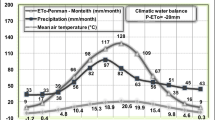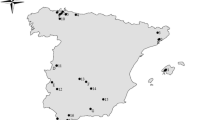Abstract.
In the present project, the time of leaf budding and flowering, and partly also of fruit ripening, was studied over 3 years in different cultivated and native plants on a gradient along a western Norwegian fjord about 300 km long, from oceanic to relatively continental regions. In the plants investigated, flowering of the red currant was most strongly favoured by oceanic conditions in the outermost part of the fjord. On the other hand, flowering of the apple was earliest in the middle district, as were flowering of the common lilac and raspberry, while differences were small between the districts for flowering of the plum and pear. In the inner district, leaf budding of the apple was about 1.5 weeks earlier than flowering of the red currant, while these two phenophases, on average, occurred on the same day in the oceanic district. The time from 1 April to flowering was generally lengthened by increased precipitation in the pear, apple, lilac and raspberry, but not in the red currant and plum. By contrast, the period from leaf budding to flowering was significantly shortened in the plum by high precipitation. The present studies also indicated that leaf budding of the birch was favoured by the high minimum temperature and the relatively high precipitation normally found in the oceanic district. Partial correlations showed that increased precipitation delayed the flowering of both rowan and bird cherry trees; there was also a week effect on bud break in the same two species. The clear conclusion of the present study, therefore, is that various plant species react differently to various climatic factors ("phenological interception"), even in different phenophases within the same species. This means that the various species are best fitted to certain climatic regions and should preferably be planted there if other growth factors are satisfactory.



Similar content being viewed by others
References
Ahas R (1997) The seasonal dynamics of Estonian landscapes: spatial and temporal variability of early-spring blossoming dates. In: Hocevar A, Crepinsek Z, Kaifez-Bogataj L (eds) Biometeorology 14, Part 2. Proceedings of the 14th International Congress of Biometeorology, Ljubljana, pp 220–225
Bassett IJ, Holmes RM, MacKay KH (1961) Phenology of several species at Ottava, Ontario, and an examination of the influence of air temperature. Can J Plant Sci 41:643–652
Batta J (1969a) Blomstring og vinterskader hos arter og kultivarer av Rhododendron (English summary). Meld Nor Landbrukshogsk 48:1–21
Batta J (1969b) Variasjoner i tid for bladsprett hos ask og eik (English summary). Årsskr Plant Dendrol 14–15:78–85
Brenchley WE (1920) On the relations between growth and the environmental conditions of temperature and bright sunshine. Ann Appl Biol 4:211–244
Caprio JM (1966) A statistical procedure for determining the association between weather and non-measurement biological data. Agric Meteorol 3:55–72
Friedel MH, Nelson DJ, Sparrows AD, Kinloch JE, Maconochie JR (1993) What induces central Australian trees and shrubs to flower and fruit? Aust J Bot 41:307–319
Garner WW, Allard HA (1920) Effect of the relative length of day and night and other factors of the environment on the growth and reproduction in plants. J Agric Res 18:553–606
Gorski T, Jazurek M (1997) Fifty-year records of flowering dates of Prunus padus L. and Robinia pseudoacasia L. in Pulawy, Poland. In: Hocevar A, Crepinsek Z, Kaifez-Bogataj L (eds) Biometeorology 14, Part 2. Proceedings of the 14th International Congress of Biometeorology, Ljubljana, pp 195–200
Hoffmann K (1969) Agrarmeteorologische Untersuchungen zur Standortsforschung in Obstbau auf der Grundlage phänologische Beobachtungen. Abh Met Dienst DDR 12:1–124
Ihne E (1884) Geschichte der pflanzenphänologischen Beobachtungen in Europa nebst Verzeichnis der Schriften, in welchen sie niedergelegt sind. Beiträge zur Phänologie. J Rickersche Buchh, Giessen, Germany
Jeanneret F (1997) From spatial sensing to environmental monitoring: a topoclimatic and phenological network through Switzerland. In: Hocevar A, Crepinsek Z, Kaifez-Bogataj L (eds) Biometeorology 14, Part 2. Proceedings of the 14th International Congress of Biometeorology, Ljubljana, pp 201–207
Köppen W (1927) Wechsel der phänologischen Zeitenfolge. Meteorol Z 44:175–177
Lauscher A, Lauscher F, Printz H (1955) Die Phänologie Norwegens. Teil I. Allgemeine Übersicht. Skr Nor Vidensk Akad Osio Mat Naturvidensk-kl 1:1–99
Lieth H (ed) (1974) Phenology and seasonality modeling. Springer, Berlin Heidelberg New York
Lindsey AA, Newman JE (1956) Use of official weather data in spring time – temperature analysis of an Indiana phenological record. Ecology 37:812–823
Linkosalo T (2000) Analyses of the soring phenology of boreal trees and its response to climate change. Univ Helsinki Dept For Ecol Publ 22, ISBN 951-45-9362-6, ISSN 1235–4449
Linné C (1751) Philosophia Botanica. Kiesewetter, Stockholm
Menzel A (1997) Results of the observations in the international phenological gardens in Europe and possibilities of modelling phenological data. In: Hocevar A, Crepinsek Z, Kaifez-Bogataj L (eds) Biometeorology 14, Part 2. Proceedings of the 14th International Congress of Biometeorology, Ljubljana, pp 214–219
Nuttonson MY (1955) Wheat-climate relationships and the use of phenology in ascertaining the thermal and photo-thermal requirements of wheat. American Institute of Crop Ecology, pp 1–388
Odland A (1996) Differences in the vertical distribution pattern of Betula pubescens in Norway and its ecological significance. In: Frenzel B (ed) Holocene treeline oscillations, dendrochronology and paleoclimate. Fischer, Stuttgart, pp 43–59
Post K (1942) Effect of daylength and temperature on growth and flowering of some ornamental florist crops. Cornell University Experimental Station Bulletin 787:1–70
Roetzer T, Chmielewski F-M (2001) Phenological maps of Europe. Clim Res 18:249–257
Schnelle F (1955) Pflanzenphänologie. Geest & Portig, Leipzig
Schübeler FC (1886) Viridarium Norwegicum I. Fabritius, Christiania
Snyder R, Spano D, Duce O, Cesaraccio C (2001) Temperature data for phenological models. Int J Biometeorol 45:178–183
Unger K, Schneider A (1956) Über Zusammenhänge zwischen Reifeentwicklung von Gemüse-Erbsen und bestimmten mikrometeorolgischen Faktoren. Züchter 26:12–22
Utaaker K, Skaar E (1970) Local climates and growth climates of the Sognefjord region. Part I. A survey of the project and climatic tables. Acta Agric Scand Suppl 18:1–18, 218
Went FW (1957) The experimental control of plant growth. Ronald, New York
Wielgolaski FE (1966) Pedicel length and floret number in Chrysanthemum × hortorum as influenced by temperature, day length and light intensity. Nytt Mag Bot (Oslo) 13:135–146
Wielgolaski FE (1974) Phenology in agriculture. In: Lieth H (ed) Phenology and seasonality modeling. Springer, Berlin Heidelberg New York, pp 369–381
Wielgolaski FE (1999) Starting dates and basic temperatures in phenological observations of plants. Int J Biometeorol 42:158–168
Wielgolaski FE (2001) Phenological modifications in plants by various edaphic factors. Int J Biometeorol 45:196–202
Wielgolaski FE, Klaveness D (1997) Norwegian plant phenology – a brief review of historical data, and a comparison of some mean first flowering dates (mFFD) for this and last century. In: Hocevar A, Crepinsek Z, Kaifez-Bogataj L (eds) Biometerology 14, Part 2. Proceedings of the 14th International Congress of Biometerology, Ljubljana. pp 208–213
Author information
Authors and Affiliations
Corresponding author
Additional information
Prepared in conjunction with the International Conference "The times they are a-changin". Climate change, phenological responses and their consequences for biodiversity, agriculture, forestry, and human health, held in Wageningen, The Netherlands, 5–7 Dec 2001.
Rights and permissions
About this article
Cite this article
Wielgolaski, F.E. Climatic factors governing plant phenological phases along a Norwegian fjord. Int J Biometeorol 47, 213–220 (2003). https://doi.org/10.1007/s00484-003-0178-y
Received:
Revised:
Accepted:
Published:
Issue Date:
DOI: https://doi.org/10.1007/s00484-003-0178-y




